Hunting waves—and peace—with the Gaza Surf Club
Grant ShillingWebsite
Could surfing really help bring Israelis and Palestinians together? Grant Shilling meets the beach bums, peace activists, and ex-soldiers who believe it’s possible
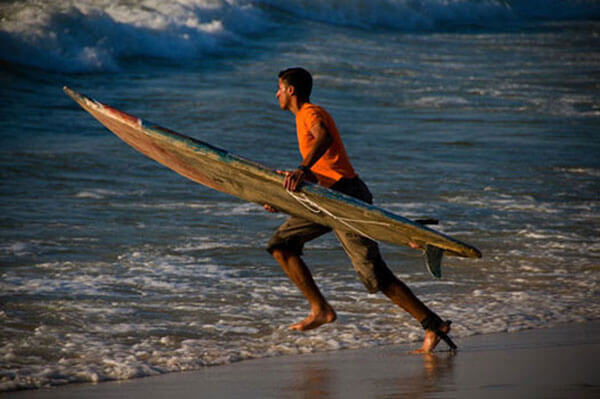
Surf’s up in Ashkelon. So I hop on the train in Tel Aviv bound for the southern Israeli city with my surfboard bag in tow. The bag, stencilled with Boards Not Bombs, attracts more than a few stares and the interest of Israeli state security at the train station. The bag is scanned, the board is tapped up and down its length, and the question has to be asked:
“You came here to surf in Israel?”
Well, yes.
“And what does this mean,” says the security soldier “Boards Not Bombs? You know we take bombs very seriously here in Israel.”
Don’t I know. I went to Israel in February 2009, during the biggest military operation in Gaza in more than a decade. Israel had launched an enormous offensive reply to years of Hamas bombs on southern Israeli towns like Ashdod, Sderot, and Ashkelon. On January 2, foreigners were ushered out of Gaza. On January 3, Israeli tanks rolled into Gaza to begin a ground offensive. A month later the death toll in Gaza was estimated to be close to 1,000 civilians.
So you can be forgiven if surfing is not the first thing you think of when Israel, Gaza, or the Middle East is mentioned. Neither is peace. But there is a thriving surf scene in Israel and an emerging one in Gaza, and both are part of the global brother- and sisterhood of surfers united by the waves that connect us all.
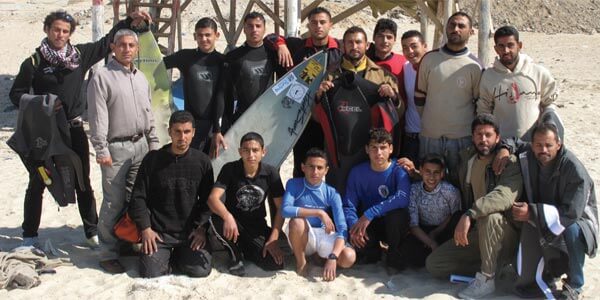
The members of the Gaza Surf Club
I’m a Jew—but my true religion is surfing. I had come to Israel because I was increasingly disturbed by the conflict between Israel and the Palestinians, and it was precisely because the situation had become so bad that I felt it necessary to see it myself. I believe surfing and peace are related: surf-ers everywhere know the peace that can come from riding a perfect wave. So I went to Israel in the hopes of delivering wetsuits to members of a loose-knit group of surfers known as the Gaza Surf Club, along with the T-shirts I made with the (now-notorious) Boards Not Bombs phrase printed on them. Call it fun over fundamentalism.
The security guard is still waiting for an answer to his Boards Not Bombs question.
“Ever hear of the Beach Boys?” I ask him.
“Of course,” he says.
“Well, it’s true,” I tell him, breaking into song. “Catch a wave, and you’ll be sitting on top of the world.”
He shakes his head like I’m meshuga and sends me through, anyway.
Once on board the train we travel south for an hour through a jumble of expressways extending out of Tel Aviv, lined by orange groves, the occasional camel, Arab and Jewish villages, and the faint blue line of the Mediterranean and its fickle waves.
On the train I meet Avram, a young Israeli soldier in uniform who is curious about my board. I tell him of my plans to surf in Ashkelon and then, hopefully, Gaza.
“I surfed Gaza,” says Avram, to my surprise. He served there during the second intifada and smuggled his board in on a troop vehicle.
“There were a few soldiers in the water and a few Gazans. Some of us lent them our boards.”
You see? I think, there it is—the aloha spirit! Not so fast. “In Gaza they said we were stealing the waves,” says Avram. “We told them, ‘learn how to surf.’”
For all the laid-back spirit of surfing, there is also a testy localism, a result of limited carrying capacity: too many surfers, not enough waves. Territorial conflict, already abundant in the Middle East, apparently extends to the beach, too. Sometimes I think the Middle East is a case of localism gone crazy—spiralling out from the Old City of Jerusalem divided into its quarters of Muslim, Jewish, Christian, and Armenian. Jerusalem is more carved up than Bobby Orr’s knee.
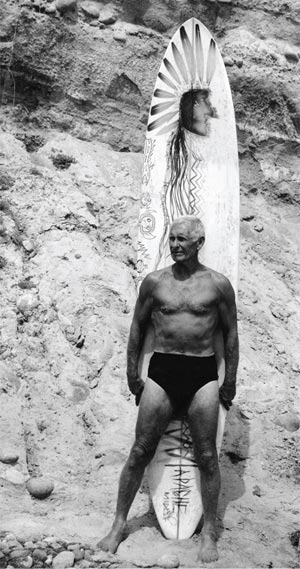
Dorian "Doc" Paskowitz
In 1956, eight years after the formation of the State of Israel, surfing arrived with the American surfer and physician Dorian “Doc” Paskowitz, the undisputed father of Israeli surfing. He brought his 10-foot Hobie surfboard with him. Four years later he returned with six surfboards, each emblazoned with the Star of David. Aiming to repopulate the world with Jews, he raised nine kids out of a 1949 Studebaker and then later in an RV, while chasing waves; his life was recently vividly captured in the feature documentary Surfwise. Paskowitz was like Moses carrying the Ten Commandments down from Mount Sinai: Thou shalt surf.
The first surfer Paskowitz taught on a Haifa beach happened to be an Arab boy. He’s been trying to bring Arabs and Israelis together to surf ever since.
The sport grew slow and steady in Israel: in the late ’70s, a group of hardcore surfers were centred in Tel Aviv. In the early ’80s, Shaun Thomson, a Jew and world champion surfer, came to Israel to teach a surf clinic. He was treated like a rock star and thousands of Israelis watched Thomson from the beach. The next year Tel Aviv played host to a stop on the World Surfing Tour.
Today there are close to 30,000 surfers in Israel. In Gaza, the scene is much smaller, with perhaps 50 or 60 surfers— equipment being one limiting factor. For instance, Salah Abu Khamil is considered the first Palestinian surfer in Gaza: now in his 40s and working in Israel, he first saw surfing on Israeli TV in the early ’80s and started out on a homemade board he painted himself. Lacking anything else suitable, he used knives for stabilizing fins.
The train station in Ashkelon has a quiet, eerie quality. The city does not see many tourists these days. In early March 2008, rockets fired by Hamas from the Gaza Strip hit Ashkelon, wounding six and causing property damage, marking the first time that Hamas had been able to reliably strike the town. In May 2008, a rocket fired from the northern Gazan city of Beit Lahiya hit this shopping mall in southern Ashkelon, causing significant structural damage and a number of injuries, but amazingly no deaths. Outside the train station is a big-box discount store. Though it’s open, the parking lot is almost empty.
Pulling up to meet me in his Toyota Corolla with a short board strapped to the roof is Chico Maayan. Maayan, now 42, a diminutive former Israeli surfing champ, has lived here in Ashkelon, a coastal community of 120,000, for 30 years. We are off to Delilah’s to check the waves there. Delilah’s is a popular beach named after the legend of Samson and Delilah, which played itself out here on the shores of Ashkelon and Gaza 15 kilometres to the south. We drive through a maze of modern white three- and four-storey apartments with red-tiled roofs separated by patches of green, the building style typical of much of Israel.
Ashkelon’s current slow pace means the waves are not crowded today. That suits Maayan fine for now, but he runs a surf school in Ashkelon, and since the bombing, business has been in the toilet. He tells me about a surf lesson he was teaching a while ago that ended abruptly.
“I was in the army, so okay, I know combat,” says Maayan. “I hear this whistling. I know it’s a rocket. I tell the kids, ‘Get down! Get down!’ The bomb landed 100 metres from us, a mushroom of smoke. We were shocked; this is the middle of summer. All the parents call me and tell me to bring the kids home. Since then it has been a problem.” (In surf lingo, catching a big wave is called “riding a bomb.” So you can imagine that Maayan’s experience brings a whole new meaning to the idea.)
This year the celebration of Purim—the festive holiday where children and adults dress in costumes that commemorate the deliverance of the Jewish people of the ancient Persian Empire from Haman’s plot to annihilate them—was cancelled in Ashkelon. “No one comes here,” says Maayan. “It’s a ghost town.”
Maayan’s parents are from Chile and came to Israel around 1960. They are proud Zionists. “My mother will kill anyone if they say anything bad about Israel,” he chuckles. Maayan served in the army during the first intifada. He describes himself as a patriotic Israeli. “Israel didn’t do enough in its recent war in Gaza,” says Maayan. “Not until we see a white flag from Hamas should we stop.”
And yet Maayan believes in a twostate solution and that Israel should support the more moderate Fatah party in Palestine. I ask Maayan how he feels about the Gazan civilians during the operation going on not far from here. “Really it didn’t bother me very much,” he says. “Sometimes I get a clinch in my heart; it’s a pity, but really, the Israeli army dropped flyers warning people to clear the area. We did our best. Hamas has got a policy that they hide behind their citizens…. Fatah is more reasonable; they recognize Israel. They are more suitable to rule. If not, then it’s like having Iran next door.”
And yet, Maayan is optimistic. “Things will get better. I love Ashkelon, I love the place, the people; I know the beaches, and this is my home.” I tell Maayan that tomorrow I plan to go to Gaza in hopes of hooking up with the surfers there and delivering some equipment. He looks at me and says, vaguely, “So you are like that, I see.”
The next day I plan to enter Gaza. Mohammed Alwayn is my surfing contact there: Alwayn is an agronomist who works for Care International. “When you surf, you don’t think about the situation,” he tells me over the phone. “When surfing, we feel free.” Alwayn and I made plans to meet up and and he’d introduce me to some of his surfing friends. All I had to do was get across the border.
My friend Arthur Rashkovan is to drive me to the Gaza border. Now 30, Rashkovan grew up two blocks from Israel’s famed Hilton Beach, home to some of the best surf in the country, and has lived there his whole life. A former Israeli skateboard champion, he’s a first-generation Israeli whose parents are from Moldova in Eastern Europe. I asked him what brought his parents to Israel and he told me, “The usual: anti-Semitism.”
Rashkovan grew up in what he calls a “mini-California, a surfer’s paradise.” Despite the conflicts, life continues as normal in Tel Aviv. It’s an extremely safe city. With a population of 400,000, street crime and homelessness are virtually nonexistent, children are free to play in the streets and parks by themselves, and women can safely walk the streets late at night in a city that never sleeps.
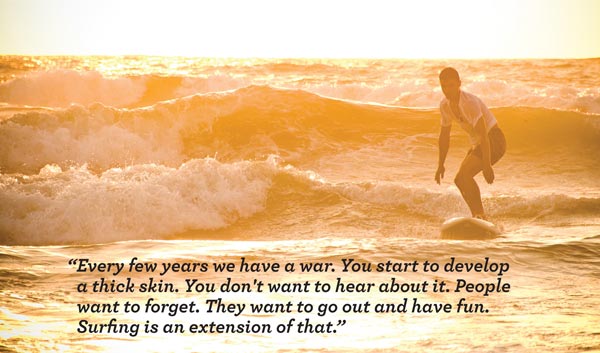
“Tel Aviv is in a bu-ah, a bubble,” says former Israeli surf pro Maya Dauber, 36. “For me, the last war with Gaza was like a reality TV show. You feel removed.
“You have to understand. This is not the first war we ever had,” says Dauber, who served in the military while being allowed to compete as a surfer in the World Qualifying Series. “Every few years we have a war. Every few years I know a soldier who died or was hurt because of a war. You start to develop a thick skin. You start to protect yourself more and more. You don’t want to hear about it. That’s why Tel Aviv is one of the best cities to hang out in in the world. Because people want to forget. They want to go out and have fun, to drink to clear their minds. Surfing,” she says, “is an extension of that.”
During his youth Rashkovan would “surf my brains out. I lived like a true beach bum. Nothing else mattered.” When he turned 18, Arthur had to serve in the military. “I realized I need to serve my country, and I didn’t want to get out of the army. So I had a goal of getting the best job I could have and keep on skating and surfing.” So he took a desk job not far from home. “My experience in the military was a lot of skate injuries,” laughs Rashkovan. “I broke my arm twice and my ankle from skateboarding. Luckily you get a very long leave to heal up, so I went on two surf trips to San Diego. The third time I got injured the army had no use for me, and they released me.”
After Rashkovan left the army he gradually became one of the prime movers and shakers in the burgeoning Israeli surf industry. In 2004, Doc Paskowitz came to Israel looking to meet some Arab-Israeli surfers. Rashkovan was in a position to help him out. Paskowitz and Rashkovan gave impromptu lessons to Arab kids on the beach between Tel Aviv and Jaffa, a spot where Israelis and Arabs surf together. “At that moment, I realized, hey, why not organize the first surf event for Arabs and Israelis?” says Rashovan. “I thought it would be a good opportunity to show that surfers can overcome barriers such as religion and politics.”
The 2004 Arab-Israeli surf contest was just the beginning. Last year, as part of something he describes as beginning as a “lark,” Rashkovan got together with Doc Paskowitz and surfing god Kelly Slater (who is of Syrian descent) to teach surfing clinics to Arabs and Israelis. They dubbed it Surfing for Peace. Young Arab girls in hijabs and young Israelis with yarmulkes caught waves with Slater looking on. Fun versus fundamentalism.
Then, pushing his luck, Doc Paskowitz, along with his sons David, Josh, and Jonathan, headed for the border to deliver some surfboards to Gaza. Despite there being a total blockade on entry, Doc managed to cajole some border guards into letting him exchange the boards with some waiting Gazans. “Kissing was the secret to getting across the border,” says Doc. “All the guys that want to shoot me, I grab them and kiss them.”
Nobody believes that you can actually bring peace simply through the act of surfing. But you can create moments of peacefulness, create some friendships, and demystify your so-called enemy. Or, as Doc says, “God will surf with the devil if the waves are good enough.”
“That day when we delivered the boards was a very magical day,” recalls Rashkovan. “We were swamped by the media. Everybody was calling me: the New York Times, the L.A. Times. I had newspapers call from Germany, South Africa, Indonesia, Brazil—really everywhere. The funniest part is we had maybe one or two minutes on Israeli TV. People are turning cynical here and indifferent. Because on one side we have war all around and we have gotten a bit insular. You get used to what’s going on around and just get on with it. The whole world was excited and Israel was like, ‘Whatever.’”
Friends asked Rashkovan why he was bothering with Surfing for Peace. “I want to prove that there are large populations on both sides who want to live their lives peacefully,” he says. “The problem is they are controlled by politicians who have other interests. Peace is a political process, but luckily friendship isn’t. Initiating actions on the grassroots level between common people is a much faster way to move things. Surfing as a peaceful way of living is just perfect for this goal. Why not just go out and forget about our worries for a moment? This what the Arabs in Israel do when they go surf, this is what the Israeli surfers do when they go out, and it’s the same for the guys in Gaza.”
Rashkovan is determined to keep Surfing for Peace grassroots and out of politics. “We know there is a huge population in Gaza that wants to live its life quietly, but it’s controlled by extremists,” he says. “I wanted to show the Gazans on the other side that there are a group of people here who want to have the same life. And maybe through the common ground of surfing show the world something else. We just want to make friends with a few guys on the other side.”
As you get closer to Gaza the highway winnows down to two narrow lanes surrounded by farm fields and overhung by orange groves. There is a sweet perfume of orange blossoms in the air. The pastoral landscape is abruptly interrupted by a clearing covered in asphalt and a big sign that reads Welcome to the Erez Crossing. The Gaza crossing looks like a hangar in a mid-size airfield with plenty of parking spaces. There are many people milling about their cars—simply waiting.
The gate has a parkade shed with a gate. At the gate Lior, a friendly, engaging young Israeli soldier, greets me. The surfboard makes him smile. I tell him surf’s up in Gaza and I want to join my Palestinian brothers on the waves.
“Not today.”
“Come on, I heard it’s as big as Indo in Gaza.” He laughs at my reference to the surf mecca of Indonesia. I spend about a half-hour trying to charm and disarm the young soldier, but there will be no getting into Gaza today—or on several other attempts I make. Hamas and Israel are still lobbing bombs at each other and things are just too hot.
Having come all this way from Tel Aviv, we stop at the Arab port of Jaffa instead to visit Rashkovan’s friend Abdallah Seri. An Arab-Israeli, Seri lives with his family in a simple flat with a patio garden. His father, a fisherman, joins us over strong Arabic coffee while a soccer game plays on the TV.
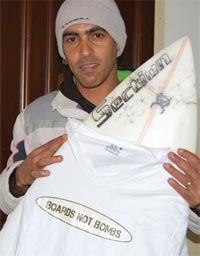
Abdallah Seri with one of the "Boards Not Bombs" T-shirts
Seri, now 28, learned to surf at the age of 12 and is part of the Surfing for Peace project. He talks about his love for Doc Paskowitz and for surfing and how it can bring people together. But then he turns serious. “The people in Gaza are not an autonomous people,” he says. “They don’t know how to think for themselves anymore, and they can’t tell right from wrong anymore. They’re victims of both the Israelis and their own Arab brothers and sisters.”
Seri’s father points to the soccer players on the screen: “Look at these guys. They’re from all over the world, playing together as a team. That is what sport can do. That is what surfing can do.”
Using surfing as an approach to solving an intractable problem like the Middle East conflict involves a leap of faith. In fact, many writers have questioned whether surfing itself is a faith. Does God reside in a double-overhead wall of blue? (The ancient Polynesians prayed over tree trunks to their god of surfing before shaping them into surfboards and built temples dedicated to the sport.)
Rabbi Nachum “Shifty” Shifren, aka the Surfing Rabbi (he wrote a book of the same title), is a deep believer in the divine peace that surfing can bestow. “I think if there is anything that can bring about peace, it’s surfing,” Shifren, a former lifeguard and triathlete, tells me by phone from Santa Monica, California. “What I am advocating is a synthesis between the physical and the spiritual. I believe that surfing is the answer to modern man’s dilemma of stress, of lack of security, of lack of self-esteem, and even in the search for peace. Surfing is a spiritual connector. It’s like a conduit where one could appreciate God and the forces of the world.”
Divine conduit or not, surfing does seem to help individuals overcome barriers to understanding. Despite his selfdescribed hardcore rightwing views, Chico Maayan also took part in the Surfing for Peace operation. “We started Surfing for Peace because we thought of it as not connected to politics—it is connected to the ocean,” he says. “We’re surfing. The Gazans are surfing. We should surf together. It won’t bring peace, but we will see the enemy differently.”
Back in Tel Aviv, I call Alwayn in Gaza to tell him I hadn’t been able to get past the border. He was hardly surprised. “Have faith,” he says.
A week after I got back to Vancouver Island, Arthur Rashkovan emailed to tell me that a German-based journalist had received permission to get into Gaza and took along four of the wetsuits I had left behind. He also took some photos of the surfers unpacking the suits in delight.
So I keep the faith. Searching for waves and peace in Israel and Gaza may be an act of faith, but this is a region, after all, that hosts three of the world’s major religions. Faith is all we’ve got, and surfing is my religion. I do believe that hope resides in a double-overhead wall of blue. Or as Chico Maayan told me, “As long as there are waves, there will be a type of peace.”
Images of the Gaza Surf Club courtesy Alex Klein, director of God Went Surfing With The Devil. Below is the trailer for that documentary: